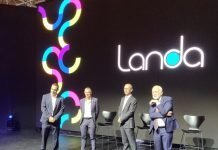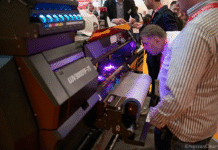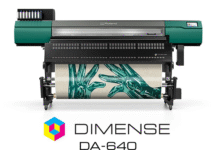Rajams Digital Offset Prints began operation in Chennai in March 2008. The company offers design and print to the Chennai market using both digital and offset presses. Recently, Rajams Digital signed up for a new Heidelberg’s SX 74, becoming the first printer in Asia to acquire a new press on the leasing or subscription model.
Rajams is a formidable early adopter of new technology using a Heidelberg Anicolor multicolor offset press along with a Komori Lithrone 426 and HP Indigo and Xerox digital presses. The printer also has a high-precision programmable cutting machine, thermal lamination, wire stitching, creasing and perforation machines making it a comprehensive quality and full service supplier with rapid turn-around times.
We recently met GN Visvakumar, who first talked about his investment in the Heidelberg Speedmaster SX 52 Anicolor, a first in the city of Chennai, and then about his decision to opt for another Heidelberg SX 74 press, this time on a subscription model, which will be installed sometime in the first week of June. “Royapettah is the printing hub in Chennai and we serve a lot of printers and freelancers here. With a highly competitive market, we felt the need to offer an edge in terms of the quality of our job work. This is the reason we opted for the Heidelberg Speedmaster SX 52 Anicolor in 2016. The press produces offset prints as easily and as quickly as digital prints, thus saving on costs at a big margin. It considerably reduces the costs for short runs and ensures best-in-class offset quality at competitive prices,” says Visvakumar.
The SX 52 Anicolor can print sheets as small as 4 x 6 inches. Printers, while cutting over-sized paper, are often left with 4 x 20-inch strips that go to waste. However, with the Anicolor, the small-sized sheets can be fed and printed for commercial work such as business cards or invitations of exceptional quality. The press supports paper thicknesses from 40 to 450 gsm, with a maximum print size of 370 x 520 mm.
Sharing the operation advantages of the Anicolor inking system, which obviates delicate and mutually variable ink and dampening balance settings on offset presses, Visvakumar says, “The machine is extremely easy to operate and does not involve tedious ink adjustments, leading to very quick and even inking. As a result, waste is reduced by up to 90% as compared with machines with conventional inking units.”
Rajams Digital already has an HP Indigo digital offset press, which can handle multicolor jobs in real offset quality with coated and uncoated substrates ranging from 60 gsm to 350 gsm with a speed of up to 2,000 copies per hour. In addition, it has a Xerox 4112 digital press—a 110 pages-per-minute high-speed black and white printer—to meet the growing requirement of print-on-demand books and other material such as bill printing.
Talking about his latest investment in the Heidelberg SX 74 press, which he opted for on a subscription model, Visvakumar says that it was his experience with the Anicolor that gave him the confidence to go for another Heidelberg. He also plans to replace the existing Komori Lithrone 426 CPC offset press with the new Heidelberg SX 74.
Klaus Nielsen explains how Heidelberg India will make the subscription model work
Heidelberg India’s managing director Klaus Nielsen explained the subscription press model to us in Chennai last week. He said, “We are pleased that our customer Rajams Digital is the first not only in India but in Asia to adopt the new subscription model for acquiring a new multicolor offset press. He is already a technology savvy printer with a Heidelberg SX 52 Anicolor press running for almost two years.”
Heidelberg India has increasingly become successful in its consumables business and so it was a step in the same direction for it to leverage its considerable assets and resources in the country with the subscription model for leasing presses to customers who are ready for it.
Nielsen explained that with this new model for capacity expansion, the customer does not need to go to the bank and merely has to sit down and discuss his plans with Heidelberg India. “The customer gives us a down payment and will pay a monthly charge for 5 years, which is based on a discussion with him that leads to us coming up with a mutually acceptable base rate,” he said, adding that since the machine belongs to Heidelberg, it can even replace it with another machine after 5 years or extend the lease period.
The advantages to the customer apart from not taking on debt are, according to Nielsen, that Heidelberg will help him to standardize production and reduce waste and technical problems. Heidelberg India will take over the maintenance responsibilities and make sure his production is competitive in every way. “We only make a profit when the customer reaches a certain number of printed sheets or output while his job becomes marketing print,” says Nielsen.
The Heidelberg subscription model – ‘Only pay for the output’
We first heard about the Heidelberg subscription model at Wiisloch from the company’s CEO Rainer Hundsdorfer, who told us in an exclusive interview, “We want to become the supplier of consumables to our customers where they don’t need to order anymore; where the materials are always there for customers with whom we have framed contracts. We can streamline some of these procurement and supply costs by having suppliers work with us.

“We want to take away some of the chores from our customers and automate them. Our industry is a little bit behind in this but we have to help our customers become automated. By doing this process we will become a kind of Amazon of the printing industry.
“Now one step further is not only providing to a customer all the consumables that he needs automatically from us but to say to the customer that he only needs to only pay for the output; to put ourselves into the responsibility for providing all the inputs. This is pretty much the same concept as the click charge of the digital printing industry. Ultimately, the customer will pay only for the output and we will build up a subscription model.
“This model may only work for the successful customers—they can lower their risks and get lower costs. So maybe what we can do today with four machines, can be done in the future with only two machines if we take the responsibility for high performance with 24/7 uptime. From these types of customers, we have all the data. The customers will have less risk and lower cost on one side and we will have more business. Of course this will only work if it is a true win-win for both sides. We already have ten customer machines that are using the subscription model.”
Hundsdorfer concluded the interview by saying, “The future lies in new structures and processes such as digital, streamlining the consumables with eCommerce and automation and the use of big data for the optimization of printing and the subscription model where the printer only pays for output. I believe the industry will be successful and Heidelberg with it.”
















